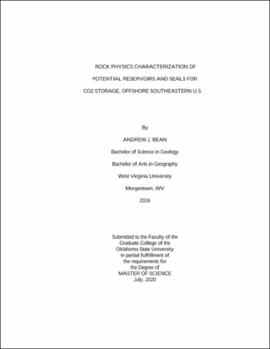| dc.contributor.advisor | Knapp, Camelia | |
| dc.contributor.author | Bean, Andrew J. | |
| dc.date.accessioned | 2021-02-22T22:41:14Z | |
| dc.date.available | 2021-02-22T22:41:14Z | |
| dc.date.issued | 2020-07 | |
| dc.identifier.uri | https://hdl.handle.net/11244/328651 | |
| dc.description.abstract | Geologic carbon sequestration is emerging as a viable method to curb anthropogenic CO2 emissions. With 40% of the United States' total CO2 emissions originating in the Southeast, proximal geologic storage sites are being characterized to reduce the region's carbon footprint. Funded by the Department of Energy, this multi-study project aims to estimate the CO2 storage potential for the 11,000 mi2 Southeast Atlantic Continental Margin (SE-ACM). Previous studies in this geologic region generated a velocity model, interpreted 2D seismic and wireline data, recommended prospective reservoirs and seals, and quantified upwards of 817 Gt of storage potential within the Upper Cretaceous, Lower Cretaceous, and Upper Jurassic formations of the SE-ACM. This research project serves to ground-truth previous findings using the only drill core in the region to mechanically characterize prospective reservoirs and seals, determine seal integrity, and refine previous estimates of storage potential with dynamic geomechanical testing and high-resolution computed tomography (CT) scanning. | |
| dc.description.abstract | An optimized workflow was designed around remaining COST GE-1 core and stipulations set by the Delaware Geological Survey to maximize data generation while also minimizing destructive analyses to preserve this rare core. Non-destructive medical CT scanner, industrial CT scanner, and multi-sensor core logger were utilized on whole core. Plugs were sampled at selected depths for porosity, permeability, and dynamic geomechanical testing. Analysis identified a positive relationship between CT number and wireline bulk density. Porosity values were used to develop a methodology to quantify interconnected porosity using 3D industrial CT scans. Finally, mechanical testing generated velocities and elastic moduli to help characterize an "auxetic" rock. With these analyses, reservoir-specific interconnected porosity values were used to refine and constrain CO2 efficiency factors. It was also recommended to revisit calculations for reservoir thickness across the SE-ACM due to apparent heterogeneity in proposed reservoir intervals. Using velocities and lithological information, seal integrity was plotted for four proposed seal intervals. The SE-ACM has great potential for CO2 storage but could benefit from additional data acquisition to improve upon previous assessments of storage volume, assess lateral continuity of seals and reservoirs, and demonstrate permanence. | |
| dc.format | application/pdf | |
| dc.language | en_US | |
| dc.rights | Copyright is held by the author who has granted the Oklahoma State University Library the non-exclusive right to share this material in its institutional repository. Contact Digital Library Services at lib-dls@okstate.edu or 405-744-9161 for the permission policy on the use, reproduction or distribution of this material. | |
| dc.title | Rock physics characterization of potential reservoirs and seals for CO2 storage, offshore Southeastern U.S. | |
| dc.contributor.committeeMember | Knapp, James | |
| dc.contributor.committeeMember | Pashin, Jack | |
| osu.filename | Bean_okstate_0664M_16898.pdf | |
| osu.accesstype | Open Access | |
| dc.type.genre | Thesis | |
| dc.type.material | Text | |
| dc.subject.keywords | characterization | |
| dc.subject.keywords | co2 | |
| dc.subject.keywords | physics | |
| dc.subject.keywords | rock | |
| dc.subject.keywords | sosra | |
| dc.subject.keywords | storage | |
| thesis.degree.discipline | Geology | |
| thesis.degree.grantor | Oklahoma State University | |
